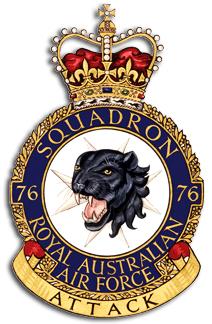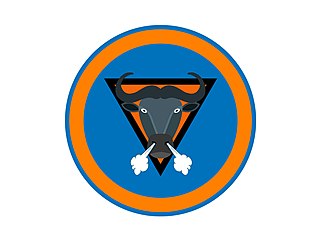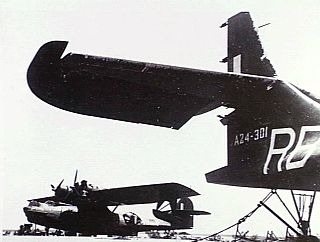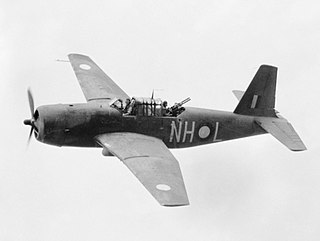
The Australian First Tactical Air Force was formed on 25 October 1944 by the Royal Australian Air Force (RAAF). Its purpose was to provide a mobile force of fighter and ground attack aircraft that could support Allied army and naval units fighting the Empire of Japan in the South West Pacific Area. One of several Allied tactical air forces formed during World War II, it evolved from the RAAF's No. 10 Operational Group, established a year earlier. Following action in the assaults on Aitape and Noemfoor, the group was renamed the First Tactical Air Force to better reflect its size and role. It was beset with morale and leadership issues in early 1945, but recovered to take part in the battles of Tarakan, North Borneo, and Balikpapan. Reaching its peak strength of over 25,000 personnel in July 1945, No. 1 TAF's squadrons operated such aircraft as the P-40 Kittyhawk, Supermarine Spitfire, Bristol Beaufighter, and B-24 Liberator. The formation remained active following the end of hostilities in the Pacific until it was disbanded on 24 July 1946.

No. 30 Squadron is a squadron of the Royal Australian Air Force (RAAF). Raised in 1942 as a long-range fighter unit, the squadron saw action in the Second World War, serving in the South West Pacific Area against the Japanese and operating mainly in the ground attack and anti-shipping roles from bases in New Guinea and the Netherlands East Indies. After the war, the squadron was disbanded, however, it was re-raised a short time later as a unit of the part-time Citizen Air Force, operating in the target towing and air defence role in New South Wales. In 1960s the squadron ceased flying aircraft and operated surface-to-air missiles, providing for the defence of Sydney and Darwin before disbanding in 1968. The squadron was re-raised again in 2010 and since then it has served as an airbase support squadron located at RAAF Base East Sale.

No. 76 Squadron is a Royal Australian Air Force (RAAF) flight training squadron. Established in 1942, it operated P-40 Kittyhawk fighter aircraft in the South West Pacific theatre during World War II. Following the end of hostilities it re-equipped with P-51 Mustangs and formed part of Australia's contribution to the occupation of Japan until disbanding in 1948. The squadron was re-formed in 1949 and three years later transferred to Malta, where it operated de Havilland Vampire jet fighters on garrison duty until again disbanding in 1955. It was reactivated in 1960 and operated CAC Sabre and Dassault Mirage III fighters in Australia until 1973. No. 76 Squadron was re-formed in its present incarnation in 1989 and is currently stationed at RAAF Base Williamtown, New South Wales, where it operates Hawk 127 jet training aircraft.

No. 16 Air Observation Post Flight was a Royal Australian Air Force (RAAF) unit that saw action in World War II supporting Australian Army operations. It was formed in October 1944 and disbanded in June 1947. The flight was reestablished in September 1958, and was disbanded again in December 1960, when its responsibilities were transferred to a joint Army-RAAF unit.

No. 120 Squadron was a joint Dutch and Australian squadron of World War II. The squadron was first formed in December 1943 as part of the Royal Australian Air Force (RAAF), and saw combat in and around New Guinea during 1944 and 1945 equipped with P-40 Kittyhawk fighters. Following the war, No. 120 Squadron was transferred to the Netherlands East Indies Air Force in 1946 and participated in the Indonesian National Revolution.

No. 42 Squadron was a Royal Australian Air Force (RAAF) mine laying and maritime patrol squadron of World War II formed in June 1944. It conducted patrol and mine-laying operations over the Netherlands East Indies (NEI) from August 1944 until the war ended a year later. It also conducted operations in the waters off southern China in early 1945. Following the Japanese surrender, the squadron performed transport and reconnaissance flights until it was disbanded in November 1945.

No. 12 Squadron was a Royal Australian Air Force (RAAF) general purpose, bomber and transport squadron. The squadron was formed in 1939 and saw combat in the South West Pacific theatre of World War II. From 1941 to 1943, it mainly conducted maritime patrols off northern Australia. The squadron was based at Merauke in western New Guinea from November 1943 to July 1944, when it was withdrawn from operations. After being re-equipped, it operated as a heavy bomber unit from February 1945 until the end of the war. The squadron continued in this role until it was redesignated No. 1 Squadron RAAF in February 1948. The squadron was reformed in 1973 to operate transport helicopters but was again disbanded in 1989.

No. 15 Squadron was a Royal Australian Air Force (RAAF) light bomber and maritime patrol squadron of World War II. The squadron was formed in January 1944 and initially flew anti-submarine patrols off the east coast of Australia. From September that year elements of the squadron took part in the New Guinea Campaign, and the main body of the squadron moved to New Guinea in March 1945. Its duties in New Guinea included anti-submarine and anti-barge patrols as well as attacking Japanese positions. No. 15 Squadron was demobilised after the end of the war, and was formally disbanded in March 1946.

No. 93 Squadron was a Royal Australian Air Force fighter squadron that operated during World War II. It was formed in January 1945 and disbanded in August 1946. Due to delays in bringing operational airfields into service, the squadron saw little combat before the end of the war.

No. 78 Wing is a Royal Australian Air Force (RAAF) operational training wing, headquartered at RAAF Base Williamtown, New South Wales. It comprises Nos. 76 and 79 Squadrons, operating the BAE Hawk 127 lead-in fighter, and No. 278 Squadron, a technical training unit. No. 79 Squadron, located at RAAF Base Pearce, Western Australia, is responsible for converting new pilots to fast jets, while No. 76 Squadron at Williamtown conducts introductory fighter courses; both units also fly support missions for the Royal Australian Navy and the Australian Army.

No. 82 Wing is the strike and reconnaissance wing of the Royal Australian Air Force (RAAF). It is headquartered at RAAF Base Amberley, Queensland. Coming under the control of Air Combat Group, the wing operates F/A-18F Super Hornet multirole fighters, EA-18G Growler electronic warfare aircraft, and Pilatus PC-21 forward air control aircraft. Its units include Nos. 1 and 6 Squadrons, operating the Super Hornet and Growler respectively, as well as No. 4 Squadron, operating the PC-21.

No. 457 Squadron was a Royal Australian Air Force (RAAF) fighter squadron of World War II. Equipped with Supermarine Spitfire fighters, it was formed in England during June 1941 under Article XV of the Empire Air Training Scheme. The squadron was transferred to Australia in June 1942 and saw combat in the South West Pacific Area before being disbanded in November 1945.

No. 17 Air Observation Post Flight was a Royal Australian Air Force artillery-spotting and liaison unit which saw action as part of the Bougainville campaign and New Britain campaign in World War II. The flight was established in October 1944 and disbanded in December the next year.

No. 78 Squadron was a Royal Australian Air Force (RAAF) fighter squadron of World War II. It was formed in July 1943 as part of expansion of the RAAF's fighter force, and was assigned to mobile striking forces for the duration of the war.

No. 82 Squadron RAAF was a Royal Australian Air Force fighter squadron that operated during World War II and its immediate aftermath. It was formed in June 1943, flying Curtiss P-40 Kittyhawks and, initially, Bell P-39 Airacobras from bases in Queensland and New Guinea. The squadron became operational in September 1944, and undertook ground attack missions against Japanese targets in the Pacific theatre. Following the end of hostilities, No. 82 Squadron was re-equipped with North American P-51 Mustangs and deployed to Japan, where it formed part of the British Commonwealth Occupation Force. It remained there until October 1948, when it was disbanded.

No. 71 Wing was a Royal Australian Air Force (RAAF) wing of World War II. It was formed in February 1943 at Milne Bay, Papua New Guinea, as part of No. 9 Operational Group. The wing initially comprised two squadrons of P-40 Kittyhawks, one of Lockheed Hudsons, and one of Bristol Beauforts. The wing's mainstay soon became the Beaufort, which eventually equipped five squadrons attached to the formation. No. 71 Wing took part in the New Guinea campaign under the auspices of No. 9 Group, before transferring to No. 10 Operational Group for the Western New Guinea campaign during 1944. It then returned to the control of Northern Command to support Australian ground forces in the Aitape–Wewak campaign, and completed its final combat mission only hours before the Japanese surrender in August 1945. No. 71 Wing remained in New Guinea following the war and was disbanded in January 1946.

No. 80 Wing was a Royal Australian Air Force (RAAF) wing of World War II. The unit was formed on 15 May 1944 and eventually comprised three squadrons equipped with Spitfire fighter aircraft. The wing's headquarters was absorbed into the newly formed No. 11 Group on 30 July 1945.

No. 61 Wing was a Royal Australian Air Force (RAAF) airfield construction wing of World War II. The wing was formed in January 1943 and was disbanded in November 1945. During the war, No. 61 Wing and the units under its command served in the North Western Area and South West Pacific Area (SWPA) and played a significant role in supporting RAAF and United States Army Air Forces (USAAF) operations.

Western Area Command was one of several geographically based commands raised by the Royal Australian Air Force (RAAF) during World War II. It was formed in January 1941, and controlled RAAF units located in Western Australia. Headquartered in Perth, Western Area Command was responsible for air defence, aerial reconnaissance and protection of the sea lanes within its boundaries. Its aircraft conducted anti-submarine operations throughout the war, and attacked targets in the Dutch East Indies during the Borneo campaign in 1945.

The Royal Australian Air Force (RAAF) operated Vultee Vengeance dive bombers during World War II. The Australian Government ordered 297 of the type in late 1941 as part of efforts to expand the RAAF. This order was later increased to 400 aircraft. A few Vengeances arrived in Australia during 1942, and large-scale deliveries commenced in early 1943; further orders were cancelled in 1944 after 342 had been delivered.




















